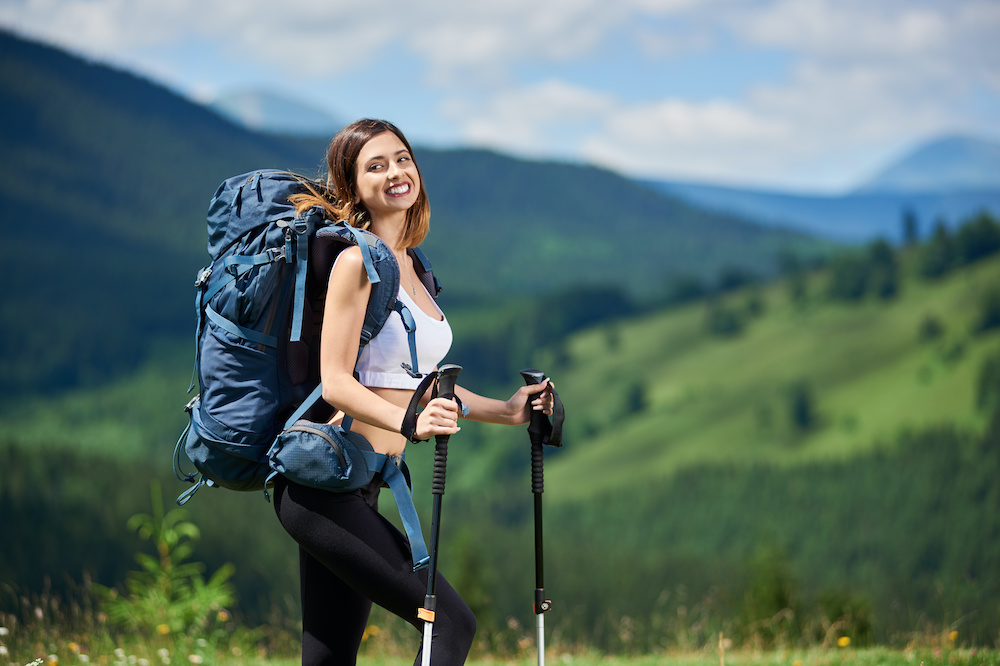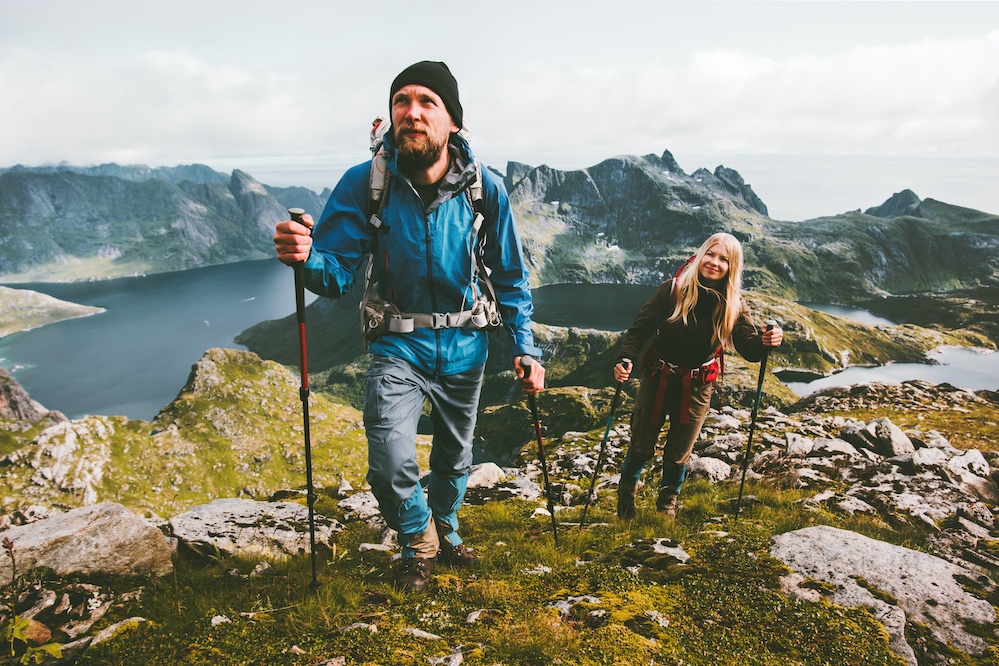
Expert hikers will tell you that your hiking gear and clothes have a larger effect on your hiking experience than the weather or terrain.
While this may be a bit of an exaggeration, it doesn’t nullify the fact that you must know what to wear hiking to have a good time.
Often overlooked, your attire can make or break the experience.
As an improperly-dressed hiker, you’ll likely be uncomfortable or even unsafe.
Let's talk about what to wear on a hike, including the right shoes and apparel, to switch modes from discomfort to enjoyment.
Basic Hiking Attire Layering
If you’re starting with shorter trails and easier terrains, you can simply call up a friend for company and leave.
However, for rougher terrains, you need to gear up. The hiking attire consists of different layers.
1. Base Layer
Quite self-explanatory, the base layer is the first item of clothing you wear when dressing for a hike.
If you’re going out in warmer weather, do not wear heavy base layers.
In contrast, wear a heavier clothing item plus long underwear for winter hiking.
- Underwear
When choosing the thickness for thermal underwear, your options are expedition weights, mid, and light.
Depending on how cold the weather is, you can select the right thickness to stay warm in the woods.
Since the base layer is in direct contact with your skin, it must be made of a fabric that soaks up moisture from your body.
Some suitable fabrics include silk, but only a few specific kinds, and merino wool.
If you’re not sure about the right material, go for athletic wear marketed as being wick-away.
These synthetic fibers are specially designed to wick sweat away from the skin.
- Socks
Moving down, the last part of your base layer is the socks.
When you’re out in the open, the first part of your body to get sweaty will be your feet.
Make sure you’re wearing weather-suitable socks.
Excessive moisture in the socks can cause blisters on your feet.
Choose wick-away socks made of wool or synthetic fibers.
As for the thickness, go for thinner socks in the summer and thicker ones for winter.
If you don’t prefer thick socks, you can wear a liner sock or layer two thin socks to get the same effect.
2. Insulating Layer
When deciding what to wear on a hike, opt for clothes that you can easily remove.
If you get too hot during the physical toil, you should be able to take off a layer.
Layering is crucial for the colder season, especially if you’re hiking on elevated terrain. The higher you go, the colder it gets.
- Pants
People are divided on whether hiking pants are the right choice for the activity or not.
If you’re hiking in the cold or don’t particularly feel pleasant about the idea of flora and fauna touching your legs, go for pants.
Make sure the pants have the right thickness and fit. You may have to try a few pairs before finding the one.
What Pants To Wear for Hiking?
Instead of designating a pair for hiking from your closet, it’s better to buy pants specifically designed for the outdoors.
Hiking pants are the Holy Grail for expert hikers, especially those lined with insulation.
For the colder weather, wear lined pants or rain pants. The latter keeps the rain away and is waterproof.
Can I Wear Leggings for Hiking?
While chunkier pants may hinder movement, leggings provide flexibility.
If you’re hiking through a bushy terrain, keep the leggings at home. Otherwise, they’ll get trashed.
Even the thickest leggings cannot withstand extreme wear and tear.
Therefore, only wear leggings if the trail is relatively smoother.
- Shorts, Skirts, and Skorts
Alternatively, you can wear a hiking skirt, shorts, or a combination of both: the infamous skorts.
These clothing items will keep you cool during the hotter weather when wearing pants might not be the most comfortable option.
However, skirts and shorts have their cons, exposed skin being the most concerning.
If you’re hiking with bare legs, make sure you check the weather beforehand.
Or, you can keep a pair of pants in your backpack in case the unexpected hits.
Moreover, don’t hit an unfamiliar trail wearing shorts. Pants are a preferred option for new trails.
When you’re on the trail with bare legs, you’re likely to come across something that may scratch or bite you.
Some things to be aware of are bugs, twigs, spiky plants, and the mighty sun.
Shorts make the best option for shorter hikes in pleasant weather.
Just like pants, look for wicking fabrics that dry quickly.
3. Shell Layer
For the top or shell layer, here are your top options:
- Jacket or a Windbreaker
Lastly, invest in a windbreaker or a water-resistant jacket with a fleece interior to wear as the top layer.
While the fleece keeps you warm on the inside, the exterior material provides waterproofing.
As their name clearly implies, windbreakers break the wind, staying immensely breathable even in milder weather.
Most windbreakers have a hard shell, making them suitable for hiking.
Alternatively, you can opt for a puffy or a jacket, often made of synthetic fibers. The outer material has lamination to keep rain and wind away.
- Vest
Another reliable, insulated clothing item is a vest.
Since a vest is closer to your body than a jacket, it keeps you warmer.
Some people avoid vests on account of them looking nerdy.
But then again, who will shame you for your dressing sense in the middle of a hiking trail?
When selecting what to wear hiking, focus on dressing for comfort and not the Vogue runway.

How Should I Dress for a Hike in the Fall and Spring?
Most basic hiking guides will only prepare you for extreme weather. But what about the spring season? What to wear for a hike in the fall?
For moderate seasons, you need to put a little extra thought into how you dress.
1. Choose the Appropriate Footwear
Since the temperature is moderate, wear hiking boots or sandals to hit the trail.
For shorter hikes, you can even wear sneakers. Sandals, though, seem to be the popular choice since they deal well with temperature fluctuations.
If there’s a rain forecast or it rained the previous day, wear boots to add traction and stay dry.
2. Layer Clothes Smartly
Again, the weather in these seasons is unpredictable, so you have to layer smartly.
A long-sleeved inner layer is the best option since it will keep your warm.
You can always remove the top or insulation layer, but the bottom layer stays put.
Moving outward, choose a zip-up fleece for warmth if the weather is a bit chilly.
As for bottoms, the convertible pants have transformed the hiking game for both amateurs and experts.
If it gets too warm, you can zip off the excess fabric from your legs. Likewise, when the surroundings start getting chilly, zip up!
3. Wear a Hat
Finally, keep a hat with you to act as a sun-deterrent. It will also help keep the rain out of your face.
What To Wear Hiking on an Unfamiliar Trail?
If it’s your first time on a trail, do not wear shorts or sandals. Wear a long-sleeved inner layer and an insulating jacket.
Do an extensive weather check before heading out.
Even if you’re not wearing it, take an insulation layer along to combat the weather changes.
Either take a friend along or let someone know about your location beforehand.
Sure enough, enjoyment is important, but safety comes first.
Hiking Footwear Options
When wondering how to dress for hiking, you also have to consider the footwear.
Keep in mind that you’ll walk among insects, rocks, loose debris, and plant roots. So, it would help if you have something to protect you from everything while providing traction.
1. Boots
Some of the best men’s waterproof hiking boots come with ankle support.
They’re perfect for higher altitudes.
If there’s a water body, such as a stream, in your way, waterproof footwear is your best bet. It’s also suitable for rainy weather.
More importantly, consider your foot shape when choosing the right hiking shoes.
Wearing boots that are too big or small on your feet will keep you uncomfortable the whole time.
For instance, the best men’s hiking boots for wide feet have excess interior space, giving the wearer more room to move their feet.
Likewise, if you have a foot condition, it’s ideal to choose specifically-designed shoes, such as hiking boots for plantar fasciitis.
2. Sandals
Secondly, you can wear hiking sandals if the weather is mild or warm.
However, sandals don’t offer as much ankle support. Also, you might sustain scratches and cuts from the plants on the trail.
If it’s too sunny, you may also get sunburns wearing sandals.
When you’re dousing yourself in sunscreen, don’t forget your feet!
Can I Wear Running Shoes for Hiking?
If you’re going for a short hike and personally prefer running shoes, you can wear them for hiking.
Again, the weather comes into play. You don’t want rain seeping into the shoes.
Instead of regular ones, opt for trail running shoes because they’re more suited for the activity.
Also, don’t buy heavy running shoes. The more a shoe weighs, the harder time you’ll have to lift your feet.
Walking up a mountain in unpredictable weather with insects surrounding you is already hard enough.
You don’t want your shoes to give you a tough time.
Hiking Accessories
Before going any further, let’s just make it clear that jewelry is a huge no-no for hiking.
But that doesn’t mean you totally have to kill your style game for a hike.
Here are some accessories you can wear:
1. Gaiters
Although not as fancy as a pair of hoop earrings, gaiters keep burrs, mud, and dirt out of your hiking boots.
2. Sunglasses
A hiking trail is the right place to show off your new Raybans.
Sunglasses allow you to see clearly while protecting your eyes.
3. Microspikes
If crampons aren’t your first pick, go for microspikes.
You can get specific versions made for different terrains and conditions.
4. Head Gear
Sunhats keep the sun out of your vision while protecting your hair and ears.
What Should You Not Wear While Hiking?
Now that you know what to wear for a hike, let’s discuss what not to wear.
1. Denim
First and foremost, leave the denim at home. Those flared jeans might flatter your physique, but they’re not for the trail.
Being hydrophilic, denim does not dry quickly. It also causes chafing in the inner thighs.
2. Cotton
Cotton is the worst material to pick when deciding what to wear when hiking.
Yes, the "I Love Hiking" cotton tees you got for the whole group need to stay home.
Cotton absorbs moisture, taking ages to dry. Even worse, it sticks to your body, making you uncomfortable.
3. Flimsy and Open-Toed Footwear
More importantly, don’t wear flimsy shoes on a hike. Hiking trails are filled with river crossings, sharp plants, and rocks.
Wearing open-toed shoes is the worst thing you can do to your feet on a hike.
4. Standard Bra
Another thing to keep in mind is not wearing bras that have clasps, especially on longer hikes.
Since you’ll be carrying your backpack for a few hours, to say the least, the weight will push the clasps against your skin.
Besides irritation, this also leads to excessive sweating. Plus, you’ll have a clasped pattern on your back by the time you get home.
A sports bra is your best friend for hiking. Make sure it’s the right size and gives ample support.
5. Loose or Bulky Clothes
Ask an expert on how to dress for hiking, and they’ll likely tell you to wear a well-fitting pair of pants and jacket.
Loose jackets and bulky pants are for streetwear. While hiking, they limit movement and cause uncomfortable rubbing.
Plus, they’re cumbersome and will be a pain to carry if you decide to take the upper layer off as the weather gets warmer.
6. Perfume
Do not wear sweet body sprays on a hike, regardless of how familiar the trail is.
Floral perfumes attract bugs, and that’s the last thing you want while hiking!
All Dressed Up for Hiking!
If you were previously puzzled by what to wear when hiking, you should have a clear idea now.
Hiking can be as fun and comfortable as you make it by choosing the right gear, accessories, and attire.
It might take a few misses, but you’ll soon be a pro at dressing appropriately for hiking by following the tips in this guide.
